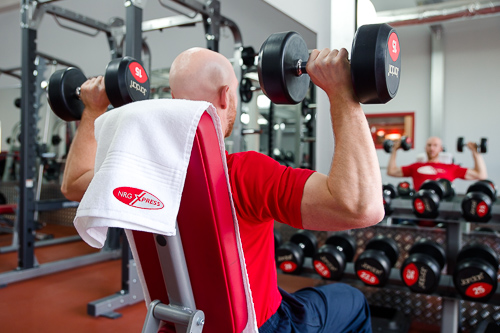Your body is a machine that constantly reinvents itself. Every minute of every day, it breaks down its own tissues and replaces them with new stuff it makes from a combination of the food you eat and recycled material it scavenges from other tissues.
No matter how old your Facebook profile says you are, your component parts are considerably younger. Even your bones replace themselves every 10 years. By that standard, your muscle cells, with an average age of 15 years under their belts, are the adults at the party.
Your workouts will cause the protein in your muscles to break down and build up much faster than it does in ordinary circumstances. In fact, when you work out with the goal of becoming more awesome than you are now, the entire point is to get that protein to turn over. But it only helps if you end up with more than you had when you started.
There are two ways to do that. The first, and by far the easiest, is to eat more protein than you currently do. Protein, all by itself, is anabolic. It wants to be stored in your muscles. The second is to work out in a way that disrupts your muscles and forces them to respond by getting bigger and stronger.
The combination of a diet rich in high-quality protein and a great strength-training program is the oldest, best, and only non-pharmaceutical way to reach that goal. This article will show you how much protein you need to eat, and when.
Part 1: How much
A 2007 study in the Journal of Applied Physiology found that muscle size increases 0.2 percent per day during the first 20 days of a strength-training program. That growth is over and above the high rate of muscle-protein breakdown that’s occurring simultaneously.
This explains why the guy who’s just starting out, or returning from a layoff, needs more protein than the weight-room warrior who’s been training for years without a break – and who is at or near his genetic ceiling for strength and size. But it’s the beginner who’s least likely to worry about his diet and most at risk of not getting as much protein as he needs.
How much is that? A good target is 1.6g of protein per kilo of body weight per day. For a guy who weighs 80kg, a day’s worth would be about 130g.
Part 2: How often
Protein synthesis is the process that takes the protein from food and turns it into muscle tissue. As Dr. Mike Roussell explains, protein synthesis is like a lamp. It’s either on or off. With 20-to-25g of high-quality protein, it’s on. More protein won’t improve the response, just as applying more force to a light switch can’t make the room brighter.
Here’s why it matters:
Most of us tend to backload our daily protein intake. We’ll have a low-protein, high-carb breakfast (a bowl of cereal with milk), a moderate-protein lunch (a turkey sandwich), and a high-protein dinner, featuring a large piece of meat or fish. But a 2014 study in the Journal of Nutrition showed that you turn more of the protein from your meals into muscle tissue when you distribute protein evenly at each meal.
In the study, protein synthesis was 25 percent higher in subjects who ate 30g of protein in each of three daily meals, compared to those who ate the same total amount but had most of it at dinner.
A recent study in the Journal of Applied Physiology found that subjects who got at least 20g of protein six times a day lost body fat and increased lean mass, with or without training. They were given a protein supplement within an hour of waking up, no more than two hours before going to bed, and every three hours in between.
Six meals may be excessive. But you probably want at least three protein-rich meals a day, especially in the early stages of a new training program. Protein synthesis will peak about 16 hours post-workout, and will remain elevated for up to 48 hours. Protein breakdown will also be higher for 24 hours.
What this means for you is that every meal counts. If you’re working out three or four times a week, your body will in effect be in the process of building new muscle every hour of every day, and also breaking down muscle at a higher rate at least half the time.
Part 3: Pre- and post-workout
For consistent, long-term lifters, protein synthesis will peak much earlier – about four hours post-workout – and return to baseline levels faster. So the protein you eat immediately before and after your workout becomes more important.
In a 2012 study in the American Journal of Clinical Nutrition, the researchers compiled data from multiple studies looking at protein and strength training. They found that those who used protein supplements gained an extra kilo of muscle over 12 weeks, compared to those who didn’t. For experienced lifters, they concluded that pre- and/or post-workout protein supplements are required to achieve maximum results.
The “window of opportunity,” when your muscles are most receptive to protein, appears to be about four to six hours, according to a 2013 study in theJournal of the International Society of Sports Nutrition. Ideally, you want a protein-rich meal two to three hours before training, and another within an hour or two after you finish.
Those who work out in the morning before breakfast have a narrower window. Protein synthesis slows down by about 15 to 30 percent while you’re sleeping, according to Dietary Protein and Resistance Exercise. So if you work out before eating, you want a post-workout meal as soon as possible.
Part 4: Best protein sources
Different types of food contain different combinations of amino acids – the building blocks of protein. Leucine is by far the most important of the 20 amino acids for creating muscle. It takes an estimated 2g-to-3g of leucine to get the maximum anabolic effect from a meal.
Just about any normal-size serving of meat or poultry will contain at least 2g of leucine (that’s roughly the size of your palm.) Three eggs, two glasses of milk, a piece of fish, or a cup of yogurt will give you about 1.5 grams. A cup of cottage cheese or scoop of whey protein (25 grams) will give you close to 3 grams.
Among plant foods, soy has the most leucine. A cup of soybeans has 2.3 grams. Beans and lentils are the next-best sources, with 1.2 to 1.4 grams per cup. A quarter-cup serving of nuts or flaxseeds will have about 0.5 grams.
Part 5: Carbs and fat
If you were reading this article a decade ago, it would tell you to eat carbs but avoid fat in your pre- and post-workout meals. The idea is that carbs before training will provide an easily accessible source of energy, while carbs afterwards will not only help replenish that energy, but also help generate insulin, a hormone that pushes nutrients into storage – in this case, escorting protein to your muscle cells. Fat, on the other hand, would be slower to digest and blunt the responses of key hormones.This was all based on the assumption that your body is a remedial student who needs you to keep things as simple as possible. Your body thinks it’s cute that you’re so concerned. Here’s what we now know:
1. Those of us with desk jobs, who sit for long hours around training, don’t need pre-workout carbs for energy. We have more than enough in reserve.
2. Unless you’re doing more than one exhausting workout a day, you have plenty of time to rebuild your energy supply. Your regularly scheduled meals should work just fine.
3. That said, there does seem to be a benefit to combining protein with carbs in a post-workout meal or supplement. It should result in slightly higher protein synthesis, according to Dietary Protein and Resistance Exercise.
4. As for fat, there doesn’t seem to be a cause for concern either way. When you’re eating and training with the goal of looking better than you do now, total calories matter more than the specific composition of those calories, or the specific way you eat them. You can be lean and muscular with a low-carb or low-fat diet, and with different combinations of meals and snacks.
Putting it all together
1. Guys who train for strength and size will get the best results with 1.6g of protein per kilo of body weight per day. That’s about 130 grams for an 80kg lifter. This daily total will probably be the most significant factor in your quest to add muscle.
2. Protein synthesis is higher when you spread that protein among three or more meals, rather than having most of it in a single meal. Shoot for at least 20g of high-quality protein in each meal to active protein synthesis.
3.Strength workouts elevate protein synthesis for up to 48 hours in new lifters, or those returning after a layoff, and about 24 hours in those with more experience.
4. Since protein synthesis slows down during sleep, it’s a good idea to eat something soon after waking up.
5. The “window of opportunity” surrounding a workout is about four to six hours. If you have a protein-rich meal a couple of hours before a workout and another soon after, you’ll take full advantage.
6. Including carbs in your post-workout meal could improve your results.

